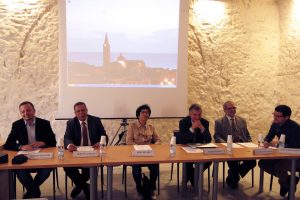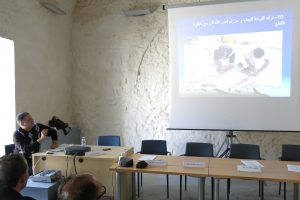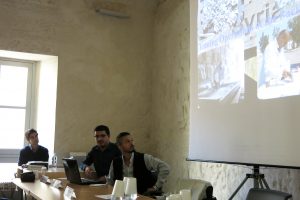Session 3: Libya and Tunisia
Session 3 included speakers from the latest two courses, MCC Libya 2014 and MCC Jordan-Syria-Tunisia 2014.
Bader Al Beraiki from the Superintendency of Benghazi, Libya, presented a conservation proposal for mosaics on the site of Tokra (Taucheria). He illustrated current conditions of the shelter and of a colored mosaic from the church, highlighting different types of deterioration mechanisms, many of which due to the past use of cement. He proposed an intervention in the following steps:
– Lift and restore the mosaics;
– Restore the shelter;
– Place the mosaics within the shelter again once it is safe.
Ashraf Bulkasim Mohammad, also from the Superintendency of Benghazi, presented a treatment proposal for mosaics in the Palace of Columns in Tolmeita, which are deteriorating as a result of inappropriate past interventions based on the use of cement. Documentation in one-to-one scale and the creation of an adequate water management system were the first recommended steps. Ashraf also proposed injections to consolidate the tessellatum, a maintenance program and the installation of physical barriers. His presentation included an estimate of time and costs.
Abdalsalam Sadoun works for the Superintendency of Cyrene, Libya. He described the current conditions of the Four Seasons mosaic in the Jason Magnus palace in Cyrene, badly deteriorated due to vandalism and lack of maintenance. Probably the most important of the site’s many mosaics, it has no protection from unauthorized visitors. The shelter is inadequate, causing water infiltrations and water accumulation on the floor. Abdalsalam’s proposal includes a new roof and overall restoration of the shelter. He also presented a program to involve the local community and increase awareness among young people on the importance of the site.
Farhani Chihaoui and Taieb Belgacem both work for the Institut National du Patrimoine (INP) of Tunisia. They discussed in situ conservation activities at Thuburbo Majus, including documentation, cleaning and filling of lacunae. In more than five years of work on site they compiled detailed condition forms and undertook photographic documentation. Extensive surface cleaning was carried out with water and sponges, while lacunae were filled using mortar that matched the color of the mosaic.
Hamadi Sillini’s presentation focused on his work for the Institut National du Patrimoine on the site of Utica. As part of a team he carried out documentation, vegetation removal, dry cleaning and wet cleaning on several mosaics in the Maison au Grand Oecus. Lacunae were filled using mortars of various types that were deemed to be compatible with the different preparatory layers. Following treatment part of the mosaics were backfilled with a layer of 15-20 cm of sand. After one year this measure proved to be effective in substantially reducing vegetation growth.













